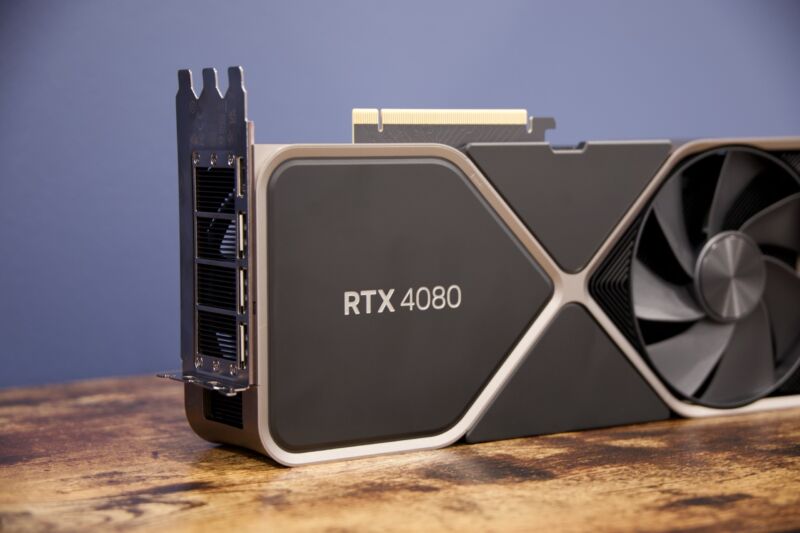
Enlarge / Nvidia's GeForce RTX 4080. (credit: Andrew Cunningham)
Very little about Nvidia's GeForce RTX 4080 is surprising—especially now that the confusing, scrapped 12GB version is being renamed. In pretty much all of our performance tests, it slots in right where you'd expect it to, comfortably ahead of the RTX 3080 Ti but trailing the $1,500 RTX 4090 by enough to justify the $300 price gap. It's usually capable of hitting or exceeding 60 fps at 4K, and games with DLSS support (or some other kind of upscaling tech) can buy you a solid frame rate increase. And its power requirements aren't as stratospheric as the 4090's, either, so most people with an existing xx70 or xx80-class gaming PC shouldn't need to switch out their power supply.
The major downsides, as of this writing? As a group, the cards are often just as huge and cumbersome as the RTX 4090 (the Founders Edition is identical, and partner cards largely follow suit). The $1,200 starting price is historically high—the 3080 Ti launched with a GPU-shortage-inflated MSRP of $1,119 GPU, but the 2080 and 3080 were both a mere $699 at launch. And even if you are willing to pay that price—surprise, surprise—it's basically impossible to find in any form anywhere close to MSRP.
Which means, hooray: another GPU review that exists mostly as a theoretical exercise! If you could buy this GPU for the amount of money it's supposed to cost, and if its competitors were also available for what they were supposed to cost, then here's how it would stack up. That world doesn't exist right now, but if you're reading this in a few months, circumstances may have changed. In the meantime, imagine with us, won't you?
Read 13 remaining paragraphs | Comments

Enlarge / Nvidia's GeForce RTX 4080. (credit: Andrew Cunningham)
Very little about Nvidia's GeForce RTX 4080 is surprising—especially now that the confusing, scrapped 12GB version is being renamed. In pretty much all of our performance tests, it slots in right where you'd expect it to, comfortably ahead of the RTX 3080 Ti but trailing the $1,500 RTX 4090 by enough to justify the $300 price gap. It's usually capable of hitting or exceeding 60 fps at 4K, and games with DLSS support (or some other kind of upscaling tech) can buy you a solid frame rate increase. And its power requirements aren't as stratospheric as the 4090's, either, so most people with an existing xx70 or xx80-class gaming PC shouldn't need to switch out their power supply.
The major downsides, as of this writing? As a group, the cards are often just as huge and cumbersome as the RTX 4090 (the Founders Edition is identical, and partner cards largely follow suit). The $1,200 starting price is historically high—the 3080 Ti launched with a GPU-shortage-inflated MSRP of $1,119 GPU, but the 2080 and 3080 were both a mere $699 at launch. And even if you are willing to pay that price—surprise, surprise—it's basically impossible to find in any form anywhere close to MSRP.
Which means, hooray: another GPU review that exists mostly as a theoretical exercise! If you could buy this GPU for the amount of money it's supposed to cost, and if its competitors were also available for what they were supposed to cost, then here's how it would stack up. That world doesn't exist right now, but if you're reading this in a few months, circumstances may have changed. In the meantime, imagine with us, won't you?
Read 13 remaining paragraphs | Comments
December 09, 2022 at 09:04PM

Post a Comment